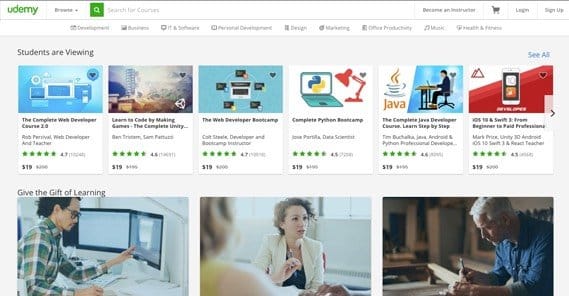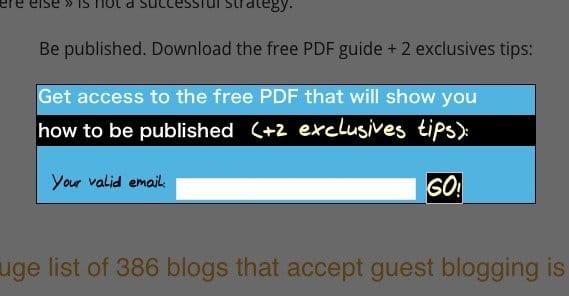30 Ways to Find New Clients for an Internet Business

In some ways, an internet-based business has it rough when attracting clients. In others, they have a huge advantage over traditional businesses.
- Traditional businesses are limited to their geographic areas.
- Online businesses have to compete against the global population.
- Online businesses have less overhead and less setup to succeed.
- Traditional businesses can be more resilient to failure.
It’s a tricky world, attracting new clients. You have a service you’re selling, and you need to find people who want to buy. You just need to navigate the obstacles placed before you; the competitors, the search engines, the issues with visibility, and all the rest. So how do you get new clients?
1. Referrals
Word of mouth is a potent form of recommendation. A review from someone you know is worth much more than that from someone you’ve never met. If you’re anything other than a brand new company, you have some clients, past or present. If they haven’t sent you referrals, send them an email and ask them to recommend your business to someone they know who might make use of your services.
Often times, satisfied customers have the best intentions, and will happily recommend you when the situation comes up. The trick is, it won’t always come up. Force the issue by drafting a personalized message to them asking for them to go out and proactively make that referral.
2. Forge Agency Relationships
Look for agencies that do what you do, but on a larger or broader scale. For example, if you manage Facebook ads for small businesses, you might look for companies that manage entire Facebook presences, or who work exclusively with large businesses.
Essentially, what you want to do is become a runoff receptacle. When a customer comes to this large agency, but the scope of the services they want is too small or their budget is too low, the agency can refer them to you. This benefits the agency, because they can do something with this customer, and it benefits you when you get the clients. It works both ways, too; when a client’s needs become too great for your brand, you can pass them off to the agency for greater services.
3. Job Boards
You can take advantage of job boards like Craigslist and Reddit’s ForHire in two ways. First, you can browse them for people looking to hire someone who does the work you do. They might not work out, but they might, and any lead is better than no lead. Second, you can actively post that you’re selling X service and you’re open for new leads. People will come to you and you can pick them up as new clients.
4. Remarketing
Remarketing is the paid advertising technique of running ads specifically to the people who have clicked on one of your ads but who didn’t follow through with a purchase.
You can do the same thing with clients, in a sense. Look through your old contacts for people who contacted you or who you contacted but who didn’t pan out as clients. Maybe the situation has changed and the time is better for selling your service. Be helpful, offer your assistance with their current projects, and perhaps even offer them a special deal if they convert away from their current consultant.
5. Actively Search Social Media
Twitter is a great place for this. Search for industry-related keywords and for mentions of your competitors. Reach out to people looking for a service similar to yours, and reach out to people who are critical of your competitors, and pitch yourself. Often, you can hook these people by promising a solution to the problems they have, either on their own or working with the competition. Again, a bonus for converting from someone else to you can go a long way here. Just try not to be too aggressive or you may come across as creepy.
6. Participate in Industry Events
Online events can go a long way towards establishing your brand presence. By participating, you show yourself to be an authority, or at least someone with a good deal of knowledge in your industry. Twitter Chats are some of the best options for this, though all sorts of events are happening all the time. In part, this ties in to networking with your industry as well. Build connections and you can refer leads back and forth, particularly with complimentary businesses.
7. Affiliate Offers
You can set up a referral program, similar to how web hosting companies give a payment to people who refer new customers. Determine how much profit you make from the average customer, and determine what a reasonable portion of that would be, that you can give as a referral bonus to the people who send in a lead that converts. You can then advertise your affiliate offer through various affiliate networks and aggregators.
8. eBooks
By offering free or cheap value to people looking for something related to your service, you can hook them in as potential customers.
For example, if you have a business selling managed Facebook ads – this is the example I’ll keep coming back to – you can write an eBook about managing Facebook ads, covering a lot of the basics and some moderate detail. You don’t want to give away all of your secrets, but you want to be valuable. Include CTAs for people to investigate your business if they don’t want to do it themselves and would prefer for you to do it for them.
9. Blog Content
Everything I just said about eBooks applies to your blog, except you have the ability to create much more content, with less detail, and more CTAs, and get away with it. Produce content, gain exposure, and hook people into your lead funnel. Every piece of valuable content is another hook in the sea, and those are all opportunities for more traffic and more sales.There are a dozen different ways you can convert a blog reader into a lead, so that’s up to you.
10. Attend Events
Industry events aren’t necessarily just limited to the online world. Plenty of events have monthly or annual conventions, trade shows, and other real world events you can attend. Schmooze with people at these events, to get your name, your brand, and your service out in the world. Refine your elevator pitch so you can explain yourself in 30 seconds, and make up business cards to hand out.
11. Sponsor Events
Sponsoring events is a way to get your brand name out there, in event programs and on decorations. As a small internet business you might not be able to sponsor something like the PGA tour, but you can get your name in local sports events and small trade shows. Work your way up as you grow. All it takes is a couple of leads to make the investment worthwhile.
12. Promote New User Bonuses
When it comes down to it, people often need an incentive to make them sign up RIGHT NOW rather than sometime down the line. By offering a time-sensitive addition, you can encourage that immediate conversion. Make sure it’s truly time-limited, though; none of that “limited time only” label on a countdown that resets every day.
13. Paid Advertising
Paying for ads on Google, Facebook, and other PPC ad networks can get a lot of exposure.
The tricky part is having the budget to actually pay for those ads. You also need to learn how to target and optimize them, lest you spend tons of money with minimal returns. PPC optimization is a huge topic, so I’ll just link to this guide.
14. Blog for Others
Writing guest posts for other blogs is a great way to expand the visibility of your brand and boost your reputation. It can also boost your site SEO via a good link, and can enhance your traffic as you grow. Try to find influential partners you can write for, and get yourself on as many relevant sites as possible with high quality content attached to your name.
15. Use Freelance Hubs
While billing yourself as a freelancer might not be strictly accurate, you can use a limited version of your service as a service you sell to people through sites like Upwork or Freelancer. If the prospective client wants more than what you provide, you can refer them to your company.
16. Education Sites
Sites like Udemy are hubs for educational courses. In much the same way that books and blog posts strive to educate and provide value laced with CTAs, you can do the same with an educational course.
The difference is, you can go into greater detail and provide some insider tips and tricks in a course, because you’re getting paid by the people who enroll in it.
17. Expand into Products
If you have a service that has a bunch of moving parts, it might be possible to create specific products for small aspects of your service, and sell or give them away. For example, Moz has a ton of tools available to their paid users, but they offer a few of them for free. It’s a great way for them to hook people with the value of a few free tools and get them paying for more.
18. Offer Integration
Many large CMS and other management platforms, like HootSuite, IFTTT, and WordPress, have ways to integrate new products and services into their platforms. If you can get an integrated form of your service into the IFTTT recipe pile or as a WordPress plugin, you can get a lot of traffic and potential customers from there. It really depends on how well you can create a stand-alone product for your service, though.
19. Press Releases
Press releases still work, but you have to be careful about using them. The days of the broad-spectrum “everyone gets a press release” bulk mail are long over. Instead, you need to find highly relevant niche publications and journals to send your release to. Places where the readers have an interest in your industry and where they might be willing to convert based on an ad they see published as a press release.
20. Magazine Ads
A lot of industries still have print publications, like Writer’s Digest or Photography magazine.
If you sell a relevant service – or you can spin your service to be relevant, like saying your Facebook marketing can help writers find readers – you can market in these publications. Just be aware that paying for print ad space can be expensive depending on the publication.
21. Go Local
An online business doesn’t have to worry about local restraints, but you can still scout your local area for potential leads. Look for local businesses who can benefit from your service and who may be over-paying for a competing service, and pitch your own to them. Sometimes, the benefit of being a local business will outweigh the drawbacks of switching, and you’ll gain a new lead.
22. Upsells
Alright, so upselling your service isn’t really gaining a new client, but getting an existing client to pay more will give you larger profit margins and will give you more budget room to play with to fund other forms of marketing to get you more clients.
23. Capture Emails
Track when a visitor arrives on your site for the first time by using cookies. If a cookie isn’t present, send them a message to opt in to your mailing list.
Your newsletter is a great source of information for users and customers, and will be a good source of new users when you segment it properly. If you’re worried about having to do this all mechanically, don’t; programs like Aweber and MailChimp do it automatically.
24. Address Pain Points
You know what your service does and what problems it solves. Utilize content and social marketing to reach out to people suffering from those problems and offer yourself as a solution. Your stable of satisfied users will help you successfully promote yourself.
25. Solicit Endorsements
Influencer marketing is all well and good, but it’s even better to have an influencer or a celebrity explicitly endorse your service. A recommendation is better than an implication.
26. Cold Calls
Obtaining a semi-targeted list of phone numbers isn’t very difficult, and the laws against cold calling for marketing have been somewhat relaxed in recent years, but you still need to be cautious with this method. Many of the younger generations don’t care for unsolicited calls.
27. Follow Up, Again
Any time a lead expresses interest but doesn’t convert, add them to a list for further targeting.
You can reach out several times to try to entice them in,
28. Poach Leads
Use competitive intelligence tools to spy on your competitors and figure out what they’re doing, marketing-wise. Make some room in your budget and go after the same things, attempting to out-do and play off of their marketing, to poach their leads.
29. Capitalize on Mistakes
Monitor your competitors and look for mistakes, bugs, and faux pas’ they commit. Capitalize on these mistakes and use them as opportunities to pitch yourself.
30. Keep At It
Be tenacious. Be persistent. Keep at it. All of these strategies are things you can do on an ongoing basis, to keep the new leads coming in.

 ContentPowered.com
ContentPowered.com












